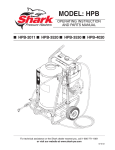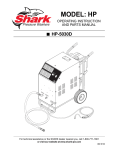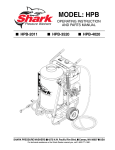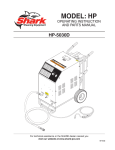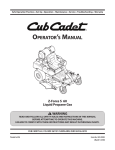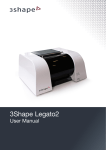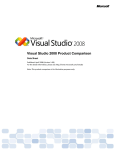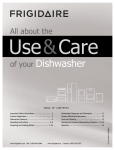Download Shark HPB HPB-2011 Specifications
Transcript
Model: HPB operating instruction and parts manual ■ HPB-2011 ■ HPB-3520 ■ HPB-3530 ■ HPB-4020 For technical assistance or the Shark dealer nearest you, call 1-800-771-1881 or visit our website at www.shark-pw.com 97-6131 machine specifications ● Pump Volume At Pump Head: ● Total Machine Amperage: 2011 2.0 GPM 2011 15 Amps 3520 3.5 GPM 3520 22 Amps 3530 3.5 GPM 3530 29 Amps 4020 4.2 GPM 4020 29 Amps ● Pump Pressure At Pump Head: ● Pump Pressure At Pump Head: 2011 1000 PSI 2011 300 Lbs. 3520 2000 PSI 3520 340 Lbs. 3530 3000 PSI 3530 515 Lbs. 4020 2000 PSI 4020 515 Lbs. ● Machine Voltage: 2011 120V/1PH 3520 230V/1PH 3530 230V/1PH 4020 230V/1PH ● Machine Dimensions: 2011Length = 31" Width = 23" Height = 40" 3520Length = 28" Width = 28" Height = 43" 3530Length = 41" Width = 32" Height = 44" 4020Length = 41" Width = 32" Height = 44" CONTENTS Introduction & Important Safety Information 4-5 Component Identification 6-8 Assembly Instructions 9 Installation 10 Operating Instructions 11 Detergents & General Washing Techniques 12 Shut Down & Clean-up 13 Storage 13 Troubleshooting 14-16 Maintenance & Oil Change Record 17 Preventative Maintenance 18-20 2011 Exploded View & Parts List 21-23 2015, 3520 Exploded View & Parts List 24-26 3530, 4020 Exploded View & Parts List 27-29 2011 Control Panel & Parts List 30 2015, 3520 Control Panel & Parts List 31-32 3530, 4020 Control Panel & Parts List 33-34 3530, 4020 Float Tank Option & Parts List 35-36 Steam Options & Parts Lists 37 Auto Start/Stop Options Exploded Views and Parts Lists 38-41 Hose & Spray Gun Assembly & Parts List 42 Burner Specifications 43 Pump Specifications 44-45 Unloader Exploded Views and Parts List 46-48 Pump Exploded Views and Parts List 49-53 Warranty Model Number ______________________________ Serial Number ______________________________ Date of Purchase ___________________________ The model and serial numbers will be found on a decal attached to the pressure washer. You should record both serial number and date of purchase and keep in a safe place for future reference. HPB 97-6131 • REV. 5/06 PRESSURE WASHER INTRODUCTION & Important Safety Information Thank you for purchasing a hot water pressure washer. This manual covers operation and maintenance of your pressure washer. All information in this manual is based on the latest product information available at the time of printing. We reserve the right to make changes at any time without incurring any obligation. Owner/User Responsibility: OPERATOR’S MANUAL WaRning The owner and/or user must have an understanding of the manufacturer’s operating instructions and warnings before using this pressure washer. Warning information should be emphasized and understood. If the operator is not fluent in English, the manufacturer’s instructions and warnings shall be read to and discussed with the operator in the operator’s native language by the purchaser/owner, making sure that the operator comprehends its contents. Owner and/or user must study and maintain for future reference the manufacturers’ instructions. This manual should be considered a permanent part of the machine and should remain with it if machine is resold. When ordering parts, please specify model and serial number. important safety information CAUTION: To reduce the risk of injury, read operating instructions carefully before using. 1.Read the owner's manual thoroughly. Failure to follow instructions could cause malfunction of the machine read operator’s manual thoroughly and result in death, serious prior to use. bodily injury and/or property damage. 2.All installations must comply with local codes. Contact your electrician, plumber, utility company or the selling distributor for specific details. To comply with National Electrical Code (NGPA 70) and provide additional protection from risk of electric shock, this hot water pressure washer is equipped with a UL approved ground fault circuit interrupter (GFCI) power cord. CAUTION risk of fire. do not use with flammable liquids. WARNING: Flammable liquids can create fumes which can ignite causing property damage or severe injury. WARNING: Do not use gasoline, crankcase drainings or oil containing gasoline, solvents or alcohol. Doing so will result in fire and/or explosion. WARNING: Do not spray flammable liquids. Operate only where an open torch is permitted. 3.This fuel burning machine shall be installed only in locations where combustible dusts and flammable gases or vapors are not present. 4.Use only kerosene, No.1 home heating fuel, or diesel fuel. WARNING: Keep water spray, wand and high pressure hose away from electrical wiring or fatal electric shock may result. Read warning tag on electrical cord. 5.To protect the operator from keep water spray away from electrical shock, the machine electrical wiring. must be electrically grounded. It is the responsibility of the owner to connect this machine to a UL grounded receptacle of proper voltage and amperage ratings. Do not spray water on or near electrical components. Do not touch machine with wet hands or while standing in water. Always disconnect power before servicing. WaRning CAUTION: Spray gun kicks back — hold with both hands. 6.Grip cleaning wand of attached pressure washer securely with both hands before starting cleaner. Failure to do this could result in injury from a whipping wand. WARNING: High pressure stream of fluid that this equipment can produce can pierce the skin and its underlying tissues, leading to serious injury and possible amputation. high pressure 7. High pressure developed by spray can pierce the attached pressure washer skin and tissues. can cause bodily injury or damage. Use caution when operating. Do not point the spray gun at anyone or at any part of the body. This machine is to be used only by qualified operators. 8.Never make adjustments on machine while it is in operation. WaRning HPB 97-6131 • REV. 5/06 WaRning protective eyewear and clothing must be worn. risk of asphyxiation. use only in a well ventilated area. WARNING: Risk of asphyxiation — Use this product only in a well ventilated area. 10. When the machine is working, do not cover or place in a closed space where ventilation is insufficient. WARNING: Risk of fire. Do not add fuel when the machine is operating or still hot. 11. Machines with a spray gun should not be operated with the spray gun in the off posirisk of fire. tion for extended periods of do not add fuel when operating time as this may cause dammachine. age to the pump. Check to make sure burner shuts off when spray gun trigger is closed. 12.Protect from freezing. 13.To prevent a serious injury, make certain quick coupler on discharge hose has locked before using pressure washer. WaRning 14.Do not allow acids, caustic or abrasive fluids to pass through the pump. 15.Inlet water must be cold and clean fresh water. 16.Do not allow CHILDREN to operate the pressure washer at any time. THIS MACHINE MUST BE ATTENDED DURING OPERATION. 17.The best insurance against an accident is precaution, and knowledge of the machine. 18.Do not operate this product when fatigued or under the influence of alcohol or drugs. Keep operating area clear of all persons. 19. We will not be liable for any changes made to our standard machines, or any components not purchased from us. 20.Do not overreach or stand on unstable support. Keep good footing and balance at all times. 21. Follow the maintenance instructions specified in the manual. 22. When making repairs disconnect from electrical source. 23. Before disconnecting high pressure hose from hot water outlet, turn off burner to allow water to cool to 100°F, then turn off pump motor and water supply and operate spray gun to relieve back pressure in hose. This will prevent coil damage from thermal expansion. OPERATOR’S MANUAL WaRning WARNING: High pressure spray can cause paint chips or other particles to become airborne and fly at high speeds. 9. Eye, hand and foot safety devices must be worn when using this equipment. PRESSURE WASHER Important Safety Information Caution: This machine produces hot water and must have insulated components attached to protect the operator. Caution: Inspect rupture disc and pressure relief devices annually for any obstruction. HPB 97-6131 • REV. 5/06 OPERATOR’S MANUAL PRESSURE WASHER Component Identification - Mini Series Fuel Tank Fresh Water Faucet (not included) Wand Holder Burner Chamber Unloader Discharge Nipple Garden Hose (not included) GFCI Pump Rupture Disc High Limit Thermostat Nozzle Coupler Insulated Spray Gun Variable Pressure Insulated Wand Control Handle Burner Motor Pump — Develops high pressure. Rupture Disc — Opens when pressure exceeds safe operating temperature. Spray Gun — Controls the application of water and detergent onto cleaning surface with trigger device. Includes safety latch. High Limit Thermostat — Controls water temperature. Variable Pressure Control Wand — Must be connected to the spray gun. This wand handle controls dishcharge flow from one tube to both wand tubes. When water is discharged from both tubes you will have High Pressure Hose a pressure loss and allows chemical siphoning when used in combination with a detergent injector. High Pressure Hose — Connect one end to water pump discharge nipple and the other end to spray gun. Note: If trigger on spray gun is released for more than 2 minutes, water will leak from valve. Warm water will discharge from pump protector onto floor. This system prevents internal pump damage. HPB 97-6131 • REV. 5/06 CAUTION HOT WATER: Must use insulated spray gun and wand. Fuel Tank Discharge Nipple Detergent Pickup Hose Pump & Burner Switch Downstream Detergent Injector Pressure Switch Control Panel Unloader High Limit Thermostat OPERATOR’S MANUAL Fresh Water Faucet (not included) PRESSURE WASHER Component Identification - Junior Series Garden Hose (not included) Burner Chamber Pump GFCI Detergent Bucket (not included) Wand Holder Burner Motor Nozzle Coupler Variable Pressure Insulated Wand Control Handle Insulated Spray Gun High Pressure Hose HPB 97-6131 • REV. 5/06 PRESSURE WASHER Component Identification - Senior Series CAUTION HOT WATER: Must use insulated spray gun and wand. OPERATOR’S MANUAL Quick Coupler Fuel Tank Discharge Nipple Burner Switch Pump Switch Control Panel Wand Holder High Limit Thermostat Pressure Switch Pump Downstream Detergent Injector GFCI Unloader Fresh Water Faucet (not included) High Pressure Nozzle Garden Hose (not included) Burner Chamber Burner Motor Detergent Pick-Up Hose High Pressure Hose Nozzle Coupler Detergent Bucket (not included) Control Handle Variable Pressure Insulated Wand Insulated Spray Gun HPB 97-6131 • REV. 5/06 Fuel Cap STEP 2: Check fuel tank and pump oil levels. STEP 3: Connect high pressure hose to discharge nipple by sliding quick coupler collar back. Insert quick coupler onto discharge nipple and secure by pushing quick coupler collar forward. OPERATOR’S MANUAL STEP 1: Connect water supply hose. PRESSURE WASHER Assembly Instructions Spray Gun High Pressure Hose STEP 4: Attach the high pressure hose to the spray gun using teflon tape on hose threads. STEP 5: Connect the high pressure hose to the pump discharge fitting. Push coupler collar forward until secure. HPB 97-6131 • REV. 5/06 PRESSURE WASHER OPERATOR’S MANUAL Installation Place machine in a convenient location providing ample support, draining and room for maintenance. Electrical: This machine is intended for outdoor use. Machine must be stored indoors when not in use. This machine, when installed, must be electrically grounded in accordance to local codes. Check for proper power supply using a volt meter. Location: Placement: The location should protect the machine from damaging environmental conditions, such as wind, rain, and freezing. 1.This machine should be run on a level surface where it is not readily influenced by outside sources such as strong winds, freezing temperatures, rain, etc. It should be located to allow accessibility for refilling of fuel, adjustments and maintenance. Normal precautions should be taken by the operator of the machine to prevent moisture from reaching the electrical controls. 2.It is recommended that a partition be made between the wash area and the machine to prevent water spray from coming in contact with the machine. Excess moisture reaching any electric components or electrical controls will reduce machine life and may cause electrical shorts. 3.During installation of the machine, beware of poorly ventilated locations or areas where exhaust fans may cause an insufficient supply of oxygen. Sufficient combustion can only be obtained when there is a sufficient supply of oxygen available for the amount of fuel being burned. If it is necessary to install a machine in a poorly ventilated area, outside fresh air may have to be piped to the burner and a fan installed to bring air into the machine. Avoid small locations or areas near exhaust fans. Do not locate near any combustible material. Keep all flammable material at least 20 feet away. Allow enough space for servicing the machine. Local code will require certain distances from floor and walls. (Two feet away from walls should be adequate.) Water Source: The water source for the pressure washer should be supplied by a minimum 5/8" I.D. garden hose with a city water pressure of not less than 30 PSI. If the water supply is inadequate, or if the garden hose is kinked, the attached pressure washer will run very rough and the burner will not fire. Connection: Connect the wand, nozzle, hose and spray gun (where applicable). On pipe thread connections, use teflon tape to avoid water leaks. (See Component Identification). Venting: Adding exhaust vent pipe to your oil fired burner is not recommended because restricted air flow causes carbon build-up, which affects the operation, and increases maintenance on the coil. If a stack must be used, refrain from using 90° bends. If the pipe can not go straight up then use only 45° bends and go to the next size pipe. The overall pipe length must not exceed 6 feet in length*. *Note: After vent pipe installation test burner using a smoke tester and adjust air setting to achieve a #3 or below results. 10 HPB 97-6131 • REV. 5/06 STEP 2: Connect the power cord into the proper electrical outlet, then push in the GFCI reset button. (Refer to serial plate for information). High Pressure Nozzle STEP 3: Grip spray gun handle securely and pull trigger. Then turn variable pressure control handle counterclockwise. Variable Pressure Wand (VP) OPERATOR’S MANUAL STEP 1: Turn water on. PRESSURE WASHER operating instructions Trigger Variable Pressure Control Handle STEP 4: Turn switch to pump position. When a steady stream of water flows from the spray gun and wand the machine is ready for cold water cleaning by turning the variable pressure control handle clockwise to raise the pressure. Selection of high or low pressure is accompanied by turning the handle. Note: High pressure nozzle must be inserted at end of wand to obtain high pressure. To apply soap read operator's manual. For hot water washing, turn the switch to the burner position. (The burner will light automatically when the trigger on the spray gun is pulled.) 11 HPB 97-6131 • REV. 5/06 PRESSURE WASHER OPERATOR’S MANUAL detergents & general operating techniques WARNING: Some detergents may be harmful if inhaled or ingested, causing severe nausea, fainting or poisoning. The harmful elements may cause property damage or severe injury. STEP 1: Connect detergent injector to discharge nipple on machine, Connect high pressure hose to injector with quick coupler(check to make sure locking coupler sleeves are in proper position before applying water pressure WaRning Discharge Nipple Quick Coupler Detergent Injector tures. When the water reaches this temperature, the pump protector engages and cools the pump by discharging the warm water onto the ground. This thermal device prevents internal damage to the pump. cleaning tips Pre-rinse cleaning surface with fresh water. Place detergent suction tube directly into cleaning solution and apply to surface at low pressure (for best results, limit your work area to sections approximately 6 feet square and always apply detergent from bottom to top). Allow detergent to remain on surface 1-3 minutes. Do not allow detergent to dry on surface. If surface appears to be drying, simply wet down surface with fresh water. If needed, use brush to remove stubborn dirt. Rinse at high pressure from top to bottom in an even sweeping motion keeping the spray nozzle approximately 1 foot from cleaning surface. Use overlapping strokes as you clean and rinse any surface. For best surface cleaning action spray at a slight angle. Recommendations: Pressure Hose STEP 2: Use detergent designed specifically for pressure washers. Household detergents could damage the pump. Prepare detergent solution as required by the manufacturer. Fill a container with pressure washer detergent. Place the filter end of detergent suction tube into the detergent container. STEP 3: Apply safety latch to spray gun trigger. Turn variable pressure control handle until discharge water exits both tubes. Secure black detergent nozzle into quick coupler if you have a single wand. NOTE: Detergent cannot be applied using Red, Yellow, Green or White nozzles. STEP 4: With the engine running, pull trigger to operate machine. Liquid detergent is drawn into the machine and mixed with water. Apply detergent to work area. Do not allow detergent to dry on surface. thermal pump protection If you run the engine on your pressure washer for 3-5 minutes without pressing the trigger on the spray gun, 12 circulating water in the pump can reach high tempera- • Before cleaning any surface, an inconspicuous area should be cleaned to test spray pattern and distance for maximum cleaning results. • If painted surfaces are peeling or chipping, use extreme caution as pressure washer may remove the loose paint from the surface. • Keep the spray nozzle a safe distance from the surface you plan to clean. High pressure wash a small area, then check the surface for damage. If no damage is found, continue to pressure washing. CAUTION - Never use: • Bleach, chlorine and other corrosive chemicals • Liquids containing solvents (i.e., paint thinner, gasoline, oils) • Tri-sodium phosphate products • Ammonia products • Acid-based products These chemicals will harm the machine and will damage the surface being cleaned. rinsing It will take a few seconds for the detergent to clear. Apply safety latch to spray gun. Remove black soap nozzle from the quick coupler. Select and install the desired high pressure nozzle. NOTE: You can also stop detergent from flowing by simply removing detergent siphon tube from bottle. HPB 97-6131 • REV. 5/06 STEP 2: Turn burner switch off and continue spraying water, allowing the water to cool. After water has cooled to less than 100°F, turn the attached pressure washer off. STEP 3: Turn off water supply. OPERATOR’S MANUAL STEP 1: Remove detergent suction tube from container and insert into 1 gallon of fresh water. Turn variable pressure wand handle for low pressure or connect the black detergent nozzle. Pull trigger on spray gun and siphon water for one minute. PRESSURE WASHER shutting down and clean-up STEP 4: Open the spray gun to relieve remaining pressure. STORAGE CAUTION: Always store your pressure washer in a location where the temperature will not fall below 32°F (0°C). The pump in this machine is susceptible to permanent damage if frozen. FREEZE DAMAGE IS NOT COVERED BY WARRANTY. 1.Stop the pressure washer, squeeze spray gun trigger to release pressure. 2.Detach water supply hose and high pressure hose. 3.Turn on the machine for a few seconds, until remaining water exits. Turn motor off immediately. 4.Drain the fuel from the fuel tank. 5.Do not allow high pressure hose to become kinked. 6.Store the machine and accessories in a room which does not reach freezing temperatures. CAUTION: Failure to follow the above directions will result in damage to your pressure washer. When the pressure washer is not being operated or is being stored for more than one month, follow these instructions: 1.Replenish pump oil to upper level. 2.Drain fuel from fuel tank, fuel line and filter. 3.Cover the pressure washer and store in a clean, dry place that is well ventilated away from open flame or sparks. After Extended Storage CAUTION: Prior to restarting, thaw out any possible ice from pressure washer hoses, spray gun or wand. 13 HPB 97-6131 • REV. 5/06 Troubleshooting Guide PRESSURE WASHER Troubleshooting problem possible cause burner will not Disconnected or short in electrical light wiring solution All wire contacts should be clean and tight. No breaks in wire. Burner motor thermal protector tripped If tripped, check voltage, connections and extensions for cause. Check fuel pump shaft rotation for binding, causing motor to overheat. On-off switch defective Check continuity through burner switch. Heavy sooting on coil and burner, can cause interruption of air flow and shorting of electrodes Clean as required. Improper electrode setting Clean and test according to diagram in operator's manual. Fuel not reaching combustion chamber Check fuel pump for proper flow. Check solenoid valve on machines with spray gun control for proper on-off flow switch. Fuel solenoid malfunction Check by placing screwdriver inside coil then turn machine on, open spray gun and check for magnetic pull. Clogged burner nozzle Replace. Water not turned on Turn on water to activate burner pressure switch. Pressure switch malfunction Remove, test for continuity and replace as needed. machine smokes Improper fuel or water in fuel Drain tank and replace contaminated fuel. Low fuel pressure Adjust fuel pump pressure to specifications. Air leaks in fuel lines Check fuel lines for leaks or air bubbles. Tighten or replace as needed. Plugged or dirty burner nozzle Replace. Faulty burner nozzle spray pattern Replace nozzle. Heavy accumulation of soot on coils and burner assembly Remove coils and burner assembly. Clean thoroughly. Misaligned electrode Realign electrodes to specifications. Fuel filter partially clogged Replace as needed. Obstruction in smoke stack Check for insulation blockage or other foreign objects. Soot build up on coils Clean coils with soot remover. Lime build up in coils Clean inside of coils using coil cleaner. 14 HPB 97-6131 • REV. 5/06 problem low water temperature water temperature too hot possible cause solution Improper fuel or water in fuel Drain fuel tank and replace with proper fuel. Low fuel pressure Increase fuel pressure. Weak fuel pump Check fuel pump temperature. Replace pump if needed. Fuel filter partially clogged Replace as needed. Soot build up on coils Clean coils with soot remover. Lime build up on coils Clean inside of coils usings coil cleaner. Improper burner nozzle See Burner Specifications. Incoming water to machine warm or hot Lower incoming water temperature. Fuel pump pressure too high Lower fuel pressure. Fuel pump defective Replace fuel pump. Detergent line sucking air Tighten all clamps. Check detergent line for holes. Defective high limit switch (thermostat) Replace. Incorrect fuel nozzle size See Burner Specifications. Insufficient water supplied Check GPM to machine. Restricted water flow Check nozzle for obstruction, proper size. PRESSURE WASHER Troubleshooting Guide Troubleshooting 15 HPB 97-6131 • REV. 5/06 Troubleshooting Guide PRESSURE WASHER Troubleshooting problem Possible cause solution low operating pressure Faulty pressure gauge Install new gauge. Insufficient water supply Use larger garden hose; clean filter washer at water inlet. Old, worn or incorrect spray nozzle Match nozzle number to machine and/or replace with new nozzle. Plumbing or hose leak Check plumbing system for leaks. Retape leaks with teflon tape. Faulty or misadjusted unloader valve (where applicable) Adjust unloader for proper pressure. Install repair kit when needed. Worn packing in pump Install new packing kit. Fouled or dirty inlet or discharge valves in pump Clean inlet or discharge valves. Worn inlet or discharge valves Replace with valve kit. Air leak Tighten all clamps. Check detergent lines for holes. Clean or replace valve in injector. detergent not drawing Valve in the injector head may be blocked, dirty or damaged pump running normally but pressure low on installation Fluctuating Pressure pump noisy 16 Filler screen on detergent suction hose plugged Clean or replace. Dried up detergent plugging metering valve Disassemble and clean thoroughly. High viscosity of detergent Dilute detergent to specifications. Hole in detergent line(s) Repair hole. Low detergent level Add detergent if needed. Discharge water temperature above 180oF. Lower discharge water temperature. Pump sucking air Check water supply and possibility of air seepage. Valves sticking Check and clean or replace if necessary. Unloader valve seat faulty Check and replace if necessary. Nozzle incorrectly sized Check and replace if necessary (See serial plate for proper size). Worn piston packing Check and replace in necessary. Valves worn Check and replace if necessary. Blockage in valve Check and replace if necessary. Pump sucking air Check water supply and air seepage at joints in suction line. Worn piston packing Check and replace if necessary. Air in suction line Check water supply and connections on suction line. Broken or weak inlet or discharge valve springs Check and replace if necessary. Excessive matter in valves Check and clean if necessary. Worn bearings Check and replace if necessary. HPB 97-6131 • REV. 5/06 This pressure washer was produced with the best available materials and quality craftsmanship. However, you as the owner have certain responsibilities for the correct care of the equipment. Attention to regular preventative maintenance procedures will assist in preserving the performance of your equipment. Contact your pressure washer dealer for maintenance. Regular preventative maintenance will add many hours to the life of your pressure washer. Perform maintenance more often under severe conditions. maintenance schedule Replace Fuel Lines Annually Pump Oil Inspect Daily inspect the oil level Change After first 50 hours, then every 500 hours or annually Clean Burner Filter Monthly (More often if fuel quality is poor) Remove Burner Soot Annually Burner Adjustment/Cleaning Annually De-scale Coil Annually (More often if required) Replace High Pressure Nozzle Every 6 months Replace Quick Connects Annually Clean Water Screen/Filter Weekly Clean Float/Supply Tank Every 6 months Replace HP Hose Annually if there is any sign of wear Grease Motor Every 10,000 hours Replace Burner Nozzle Annually Replace Rupture Disc Annually PRESSURE WASHER Troubleshooting Guide Maintenance Charts Oil Change Record Date Oil Changed Month/Day/Year Estimated Operating Hours Since Last Oil Change Date Oil Changed Month/Day/Year Estimated Operating Hours Since Last Oil Change 17 HPB 97-6131 • REV. 5/06 PRESSURE WASHER OPERATOR’S MANUAL Preventative Maintenance 1.Use clean fuel — kerosene, No. 1 home heating fuel or diesel fuel. Clean or replace fuel filter every 100 hours of operation. Avoid water contaminated fuel as it will seize up the fuel pump. De-soot coils monthly. Use an additive if diesel is being used. 2.Check to see that the attached pressure washer water pump is properly lubricated. 3. Follow winterizing instructions to prevent freeze damage to pump and coils. 4.Always neutralize and flush detergent from system after use. 5.If water is known to be high in mineral content, use a water softener on your water system, or de-scale as needed. 6.Do not allow acidic, caustic or abrasive fluids to be pumped through the system. 7.Always use high grade quality cleaning products. 8.Never run attached pressure washer pump dry for extended periods of time. 9.If machine is operated with smoky or eye burning exhaust, coils will soot up, preventing water from reaching maximum operating temperature. (See section on Maintenance and Service). 10.Never allow water to be sprayed on or near the motor or burner assembly or any electrical component. 11.Delime coils as per instructions. It is advisable, periodically, to visually inspect the burner. Check air inlet to make sure it is not clogged or blocked. Wipe off any oil spills and keep equipment clean and dry. The areas around the pressure washer should be kept clean and free of combustible materials, gasoline and other flammable vapors and liquids. The flow of ventilating air to the burner must not be blocked or obstructed in any manner. MAINTENANCE AND SERVICE Unloader Valves: Unloader valves trap pressure in the line when a shutoff spray gun is closed. Machines with unloader valves are preset and tested at the factory before shipping. Occasional adjustment of the unloader may be necessary to maintain correct pressure. Winterizing Procedure: Damage due to freezing is not covered by warranty. Adhere to the following cold weather procedures whenever the washer must be stored or operated outdoors under freezing conditions. During winter months, when temperatures drop below 32°F, protecting your machine against freezing is nec18 essary. Store the machine in a heated room. If this is not possible then mix a 50/50 solution of anti-freeze/ water or windshield washer fluid with water in a 5 gallon bucket. Place a short section of garden hose into the bucket and connect it to the machine. Elevate the bucket and turn the pump on to siphon the anti-freeze through the machine. If compressed air is available, an air fitting can be screwed into the inlet connector and by injecting compressed air, all water will be blown out of the system. If you have an optional float tank, pour the antifreeze into this tank and run machine until antifreeze exits discharge nipple. High Limit Hot Water Thermostat: For safety, each machine is equipped with a high limit control switch. In the event the temperature of the water should exceed its operating temperature, the high limit control will turn the burner off until the water cools. Pumps: Use only SAE 30 weight non-detergent oil. Change oil after first 50 hours of use. Thereafter, change oil every three months or at 500 hour intervals. Oil level should be checked by using the dipstick found on the top of the pump or by the red dot visible through the oil gauge window. Oil should be maintained at that level. Cleaning of Coils: In alkaline water areas, lime deposits can accumulate rapidly inside the coil pipes. This growth is increased by the extreme heat build up in the coil. The best prevention for liming conditions is to use high quality cleaning detergents. In areas where alkaline water is an extreme problem, periodic use of deliming powder will remove lime and other deposits before coil becomes plugged. Deliming Coils With A Pressure Washer: Periodic flushing of coils is recommended. Step 1 Fill a 5 gallon bucket with 4 gallons of water, then add 1 lb. of deliming powder. Mix thoroughly. Step 2Remove the high pressure nozzle from the pressure wand and put the wand into the bucket. Secure the trigger on the spray gun into the open position. Step 3Attach a short section (3-5 ft.) of garden hose to the attached pressure washer to siphon solution from the elevated bucket. Start up pressure washer, allowing solution to be pumped through pressure washer and into HPB coils and back into the bucket. Solution should be allowed to circulate 2-4 hours. Step 4 After circulating solution flush entire system with fresh water. HPB 97-6131 • REV. 5/06 Electrode Setting - Wayne: In the heating process, fuel residue in the form of soot deposits may develop between the heating coil pipe and block air flow which will affect burner combustion. When soot has been detected on visual






















































